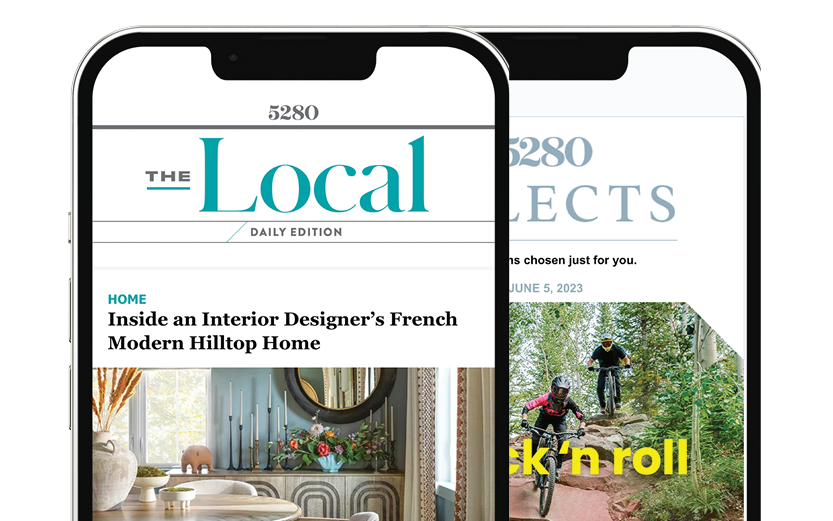The Local newsletter is your free, daily guide to life in Colorado. For locals, by locals.
Growing up on the East Coast, Kenneth Wan and Doris Yuen rang in the Lunar New Year by attending big banquets, visiting family and friends, and collecting piles of hongbao (red envelopes filled with money, often gifted to children). Because Denver’s Asian community is much smaller than those found in Massachusetts and Rhode Island—where Wan and Yuen spent their childhoods, respectively, before meeting in New York City as adults—it’s even more important for the couple to find ways to share their Chinese American traditions with their three-year-old daughter, Autumn. “I want her to understand her culture, appreciate who she is, and grow up in an environment where she sees Chinese food and Asian culture being appreciated,” Yuen says.
Showcasing their heritage through food is part of Wan and Yuen’s day-to-day lives as the owners of year-old, elevated fast-casual MAKfam in Baker, where they serve dishes inspired by their upbringings as the children of Chinese immigrants. Visitors are welcome to enjoy the family-style fare—everything from corned beef fried rice to house-made chicken and chive dumplings—in the neon-accented dining room or take it back to their own kitchen tables to share.

“I want to be a part of building a community for the people here to feel hope, to feel a sense of belonging,” Yuen says.
Lunar New Year, which was designated an official holiday in Colorado in 2023, honors the first new moon of the lunar calendar used in many countries across Asia and the rotation of the Chinese zodiac. At home, Wan and Yuen prepare meals packed with symbolism to mark the holiday. These lucky foods, including noodles, whole fish, and dumplings, are believed to invite happiness, good health, and affluence.
In celebration of the upcoming Year of the Snake, Wan and Yuen encourage everyone to try out the following recipes—staples on their own Lunar New Year table.
Lunar New Year Recipes:
- Veggie Spring Rolls
- Ho See Fat Choy
- Black Sesame Tong Yuen
- Whole Steamed Fish
- Longevity Noodles
- Hiss Hiss Bang Bang Cocktail
- Chicken Wontons
Veggie Spring Rolls

Spring rolls, which resemble bricks of gold, are a symbol of prosperity. This Cantonese-style recipe uses spring roll skins that are thinner and crispier than those used for egg rolls. Look for them in the fresh and frozen aisles of Asian markets.
Ingredients (makes about 18–20 spring rolls):
- 10 oz. bean thread noodles
- ¼ cup canola oil
- 1 lb. shredded carrot
- ½ lb. chopped shiitake mushrooms
- 2 lb. shredded cabbage
- 1½ Tbsp. kosher salt
- 1½ Tbsp. vegetable bouillon powder
- 2½ Tbsp. light soy sauce
- 1 Tbsp. mushroom soy sauce
- 4 Tbsp. vegan oyster sauce
- 1 Tbsp. sesame oil
- 1 package spring roll wrappers
- 2 Tbsp. cornstarch
- 3 quarts canola oil, for frying
- Kosher salt (to taste)
- Plum sauce, for serving
Directions:
1. In a bowl of warm water, soak the bean thread noodles for 30 minutes prior to cooking the recipe (don’t use hot water, which will make them mushy). Heat the canola oil in a large wok over medium-high heat and sweat the carrots and shiitake mushrooms until tender, about five minutes. Add the shredded cabbage and cook down for another three to four minutes, adding extra oil if the mixture looks dry.
2. Remove the pan from the heat and fold in the softened bean thread noodles. Season the mixture with salt, vegetable bouillon powder, light and mushroom soy sauces, oyster sauce, and sesame oil and mix well. Allow to cool before rolling the spring rolls.
3. Make a glue to seal the spring rolls by dissolving the cornstarch in two tablespoons of boiling water in a small bowl and set aside. To wrap the spring rolls, place the wrapper on a flat surface with a corner facing you. Place about a quarter cup of the filling about two inches from the corner. Fold the corner over and under the mixture (like a burrito). Then, fold in the two corners on the left and right so they meet in the middle. Continue rolling the spring roll into a cigar shape. To seal the package, brush a little of the cornstarch mixture on the edges of the corner that’s farthest away from you.
4. To fry the spring rolls, heat two to three inches of canola oil to 350 degrees (check the temperature with a thermometer); fry the spring rolls in small batches until golden brown, about five minutes. Season with a sprinkling of salt to taste. Serve with plum sauce.
Ho See Fat Choy

Yuen and Wan’s rendition of this traditional Chinese dish starring fat choy (a silky, hairlike algae that is a symbol of wealth) uses dried oysters, bok choy, and shiitake mushrooms. If you can’t find oysters and black moss in the dried goods section of your Asian market, look for them online.
Ingredients (serves 6–8):
- 1 cup dried shiitake mushrooms
- ½ cup dried oysters
- ½ oz. Chinese black moss
- ½ lb. Shanghai bok choy, washed and quartered
- ½ cup canola oil
- 8 oz. boiled lotus root (about 1 cup)
- 1 Tbsp. oyster sauce
- ½ cup soy sauce
- ½ tsp. chicken bouillon powder
- 1 Tbsp. cornstarch
Directions:
1. Place the dried shiitakes, oysters, and black moss separately into bowls of water and allow each ingredient to soak for about one hour. The mushrooms will plump up, and the black moss will double in size. In the meantime, blanch the bok choy to help the vegetable retain its color and texture.
2. Slice the shiitake mushrooms or leave them whole. In a large pot or Dutch oven, heat oil over medium-high heat; sear the shiitakes until light golden brown. Stir in the lotus root and continue to cook with mushrooms, one to two minutes.
3. Add in one quart of water along with the dried oysters, black moss, oyster and soy sauces, and chicken bouillon powder and stir until well combined. Once boiling, reduce heat to a simmer and cook, covered, for about one hour. Fold the bok choy into the mixture. Make a slurry by mixing the cornstarch with one tablespoon of water; add it to the pot to thicken the sauce. Let the ho see fat choy simmer for two to three minutes, then remove it from the heat to avoid overcooking the ingredients.
Black Sesame Tong Yuen

Often served in a ginger syrup, these chewy, black-sesame-stuffed rice dumplings signify togetherness, good fortune, and prosperity. The most difficult part is getting the dough hydration right. If it’s too dry and the dough cracks while you’re folding the dumplings, try kneading a few drops of water into it. If it’s too wet and the mixture is too sticky to handle, work it without adding water, which lets some of the moisture evaporate.
Ingredients (serves 6–8):
For the filling:
- 1 cup black sesame paste
- 1 cup sugar
For the ginger syrup:
- 2 cups sugar
- 3 cups water
- 1 2-inch knob of ginger, peeled and sliced
For the dough:
- 3 cups glutinous rice flour
- 1½ cups warm water
- Canola oil, for greasing your hands
Directions:
1. Make the filling by mixing the black sesame paste and sugar in a bowl. Place in the fridge so it’s easier to handle later.
2. Make the ginger syrup by adding the sugar, water, and ginger to a pot and bringing it to a boil. Turn the heat off and set aside.
3. Make the dough by placing the rice flour into a bowl and slowly adding the water while mixing well. Knead until the dough is in one smooth ball.
4. Grease your hands lightly with oil. Take a tablespoon-size portion of the dough and flatten it between your hands until it’s around two inches in diameter, with the edges slightly thinner than the center. Add a half tablespoon of the chilled filling to the center of the dough and close the dough over the filling. Gently roll the dumpling between your palms to make a neat ball, and set aside. Repeat to make the rest of the dumplings, keeping the dough covered between uses to prevent it from drying out.
5. Bring a pot of water to a boil over high heat while rewarming the ginger syrup. Drop the tong yuen into the boiling water while continuously stirring to prevent sticking. Cook for two to three minutes, taste for doneness (the dumpling should have a silky texture), then drain with a slotted spoon and serve in bowls with ginger syrup, to taste.
Whole Steamed Fish

Whole fish, a symbol of abundance, is eaten during Lunar New Year in hopes of ushering in a year filled with prosperity—and delicious food. If you don’t have a pot large enough to accommodate your fish, you can use a bamboo steamer. Ask your fishmonger to clean, descale, and score your tilapia crosswise, which will help it cook evenly and soak up flavor.
Ingredients (serves 6–8):
- 1½–2 lb. whole tilapia, cleaned, descaled and scored crosswise
- 1 Tbsp. salt
- 2 tsp. white pepper
- ¼ cup cooking wine
- ¼ cup light soy sauce
- ¼ cup scallions, chopped
- ¼ cup cilantro leaves
- 1 1- to 2-inch knob of ginger, peeled and sliced into matchsticks
- ½ cup canola oil
Directions:
1. Season the exterior and interior cavity of the tilapia with salt, white pepper, cooking wine, and light soy sauce on a large, heat-proof plate. Put a steamer rack inside a lidded pot, such as a wok or Dutch oven, big enough that the plate with the fish will fit inside.
2. Fill your pot with just enough water (about one to two inches) to cover the steamer rack, then carefully place the plate with the fish on top and bring the water to a boil over medium-high heat. Put the lid on and let the tilapia steam for 12 minutes. Remove the plate from the pot and garnish the fish with scallions, cilantro, and ginger.
3. In a small pot, heat the canola oil over medium-high heat until it shimmers or you see wisps of smoke (three to five minutes). Pour the hot oil over the fish.
4. Finish with a dash of light soy sauce to taste, and serve immediately.
Longevity Noodles

E-fu noodles (also known as yi mian) represent longevity in Chinese culture and traditionally should not be broken before consumption. You can find the noodles, which are fried until crispy and come as a dry brick, at Great Wall Supermarket in the Athmar Park neighborhood.
Ingredients (serves 6–8):
- 1 package (200 grams) e-fu noodles
- 3 Tbsp. canola oil
- 2 cups shiitake mushrooms, stalks trimmed and cut into ¼-inch slices
- 6 Tbsp. light soy sauce
- 4 tsp. sesame oil
- 1 ½ tsp. chicken bouillon powder
- 1 bunch scallions, sliced (just the green ends)
Directions:
1. In a large pot, bring three quarts of water to a boil. Place the e-fu noodles into the water and cook for four to five minutes, stirring occasionally, until they are separated and soft. Strain the noodles.
2. Meanwhile, in a large skillet or wok, heat the canola oil over medium-high heat. Stir-fry the shiitake mushrooms until lightly golden brown, around two to three minutes.
3. Add the drained noodles, light soy sauce, sesame oil, and chicken bouillon powder, and mix well. Garnish with the scallions.
Hiss Hiss Bang Bang Cocktail

In honor of the upcoming Year of the Snake, MAKfam bar manager Grace Tomczak crafted this tangy, subtly floral sipper. The drink is red, an auspicious color in Chinese culture, thanks to the addition of hibiscus tea, which you can buy at many natural food stores or online. To make the lychee syrup, blend one 15- to 20-ounce can of drained lychees with equal parts water and sugar and strain.
Ingredients (makes 1 drink):
- 1½ oz. vodka
- ½ oz. vermouth bianco
- ¾ oz. lemon juice
- 1 oz. lychee syrup
- 10 drops rice vinegar
- 2 oz. hibiscus tea, for topping
- Mint sprigs and lychee candy, for garnish
Directions:
1. Shake the first five ingredients with ice.
2. Strain into a 10- to 14-ounce Collins glass filled with fresh ice, top with the hibiscus tea, and garnish with mint sprigs and lychee candy.
Chicken Wontons

To make these wontons shaped like gold ingots, Wan and Yuen source their wrappers from Kwan San Noodle Company, a Denver-based brand available at many local Asian markets. They also recommend the Twin Marquis brand, which produces thinner Hong Kong–style and thicker Shanghai-style wonton skins. Any of the above will work for this recipe.
Ingredients (makes around 40 wontons):
- 1 lb. minced chicken breast or thigh meat
- ½ tsp. white pepper
- 1 tsp. chicken bouillon powder
- 1 tsp. MSG
- 1 tsp. sesame oil
- 1 Tbsp. sugar
- 1 Tbsp. salt
- 2 Tbsp. light soy sauce
- 1 Tbsp. oyster sauce
- 1 whole egg, beaten
- 1–2 packs of wonton wrappers (40 to 50 skins)
Directions:
1. Combine all of the ingredients except the wrappers in a mixing bowl. Mix well using a spatula, or gently massage the mixture with your hands. Place the filling in a medium bowl and set aside.
2. Create a wonton folding station that includes a small bowl of water, a large plate or baking dish with flour sprinkled on top (to hold wrapped wontons until they’re cooked), and the bowl of wonton filling placed in a larger bowl of ice.
3. Place a wonton wrapper in the palm of your hand and put about a half tablespoon of the meat filling in the center of the wonton wrapper. (Don’t use too much meat, or the wontons will be difficult to fold and seal properly.)
4. Dab a finger in the small bowl of water and wet all four edges of the wonton wrapper. Fold the wonton in half, making a rectangle, and be sure to seal each edge nice and tight.
5. Dab water onto both sides of the wonton (it should be sitting horizontally in your hand). From the folded side of the rectangle, bring both corners to overlap in the center and pinch them together, making sure that all sides are sealed and the bottom is flat. Your folded wonton should resemble the shape of a gold ingot.
6. Bring a large pot of water to a rolling boil over medium-high heat. A big pot should be able to cook all the wontons, while a smaller pot will likely fit eight to 10 pieces at a time. When the wontons float to the top, turn off the water and let them sit for an additional two minutes. Strain the wontons and enjoy with your favorite condiment, such as soy sauce with chile oil.
7. To freeze the wontons to cook later, put them on a sheet pan after you fold them and pop them into your freezer. Once frozen, you can store them in a Ziploc bag for up to three months.
Read More:









